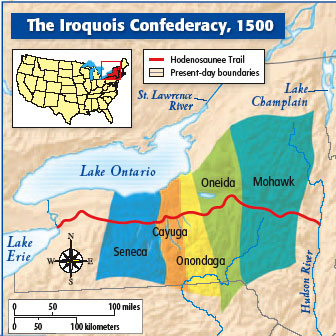Iroquois Confederacy
- From teachinghistory.com, review of the question: Did the Iroquois influence the Founders?
- Encyclopedia Britannica
- The Constitution of the Iroquois Confederacy
- Bibliography from the Iroquois Museum
- The Six Nations (includes a digitized copy of Forgotten Founders, Benjamin Franklin, the Iroquois and the Rationale for the American Revolution, by Bruce E. Johansen, 1982.)
- Dekanawidah's Great Law
- Hiawatha, a poem by Henry Wadsworth Longfellow, 1855
- Hiawatha and the Iroquois Confederation: A Study in Anthropology, 1881.

by John Kahionhes Fadden
Images of the Six Nations are identified by the style of hat they're wearing
located about the six smokeholes.
Dekanawidah is regarded as the author of the Great Law of the Iroquois Confederacy that bound together five Indian Nations, probably early in the late Fifteenth or early Sixteenth Century. A somewhat similar Huron Confederacy is believed to have been instituted in 1450. The Iroquois Great Law replaced cycles of murder, revenge, and violent destruction of villages with a system of justice administered by hereditary chiefs. It is one of the earliest North American constitutions of which we have some knowledge, having been passed down orally with the mnemonic aid of shell-bead patterns, or wampum.
The names of the five nations—Mohawks, Oneidas, Onondagas, Cayugas, and Senecas—were recorded by the first European explorers early in the Seventeenth Century. However, it was not until the Eighteenth Century that the legends of the formation of the Confederacy began to be written down. The process continued, with variations and successive elaboration, into the early Twentieth Century.
Contrary to his portrayal by Longfellow, Hiawatha was a statesman, peacemaker, and co-founder of the Iroquois League, Confederacy, or Confederation. The pioneering nineteenth-century linguist Horatio Hale published in 1881one of the earliest recorded versions of Hiawatha’s story, and the one probably closest to historical fact.